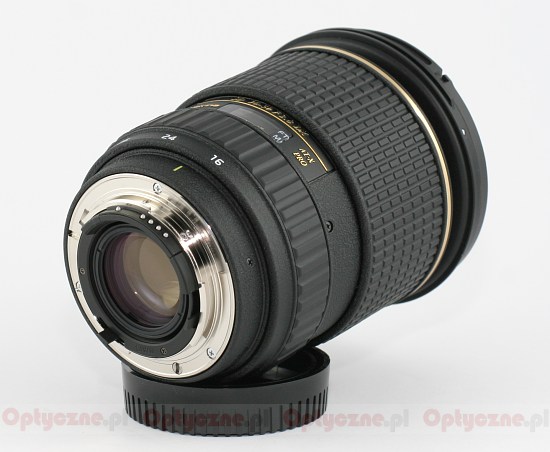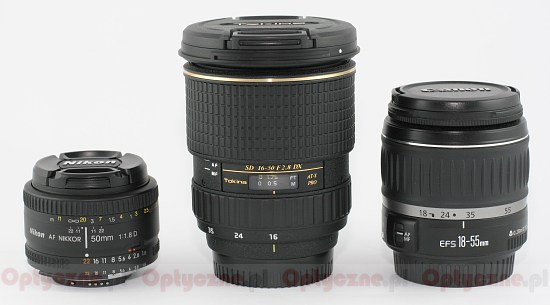Tokina AT-X 165 PRO DX AF 16-50 mm f/2.8
3. Build quality
 |
Of course the solidity and the significant number of elements mean that the lens can be quite heavy – 610 grams in this case – and physically big for a kit lens’s substitute (it can be seen in the picture below).
 |
Please Support UsIf you enjoy our reviews and articles, and you want us to continue our work please, support our website by donating through PayPal. The funds are going to be used for paying our editorial team, renting servers, and equipping our testing studio; only that way we will be able to continue providing you interesting content for free. |
- - - - - - - - - - - - - - - - - - - - - - - - - - - - - - - - - - - - - - - - - - - - - - - -
First thing that sticks out is a huge, ribbed and comfortable...manual focus ring. Unfortunately we find it in a place usually occupied by a zoom ring. It is quite bothersome because each time we make a grab at the wrong device. What’s more, that ring features something that Tokina calls ‘One-touch Focus Clutch Mechanism’. It means that when the ring is positioned close to the body we can set the focus manually and when we pull it toward the rim of the lens, we change into the AF mode – the ring still rotates but it’s not engaged to any of the internal focus gearing. Now imagine you are in a hurry and you want to shoot a picture: you put the camera against your face, you grab at the lens, you turn and turn and…nothing. After a split of a second you finally realize that you have been turning the wrong ring and to change the focal length you must look for something nearer the body.
Personally I am not a fan of this type of AF to MF mode changing, especially that it always causes small shifts of the focus scale and noticeable resistance…
The zoom ring, as we already mentioned, although comfortable, could have been wider and positioned near the middle of the lens. It moves smoothly and is well-damped but it works with more slack in the range of 16-30 mm and is distinctly more resistant over 30 mm.
When you increase the focal length, the front element system extends on a telescopic inner tube so the lens becomes almost 14 cm longer. Fortunately the system doesn’t rotate either during the extension or focusing so it can cooperate with different filters without any problems. The filters would be 77 mm in diameter in this case.
When it comes to the inner construction, the Tokina boasts 15 elements in 12 groups. One of the elements is made of low dispersion SD glass and some aspherical elements have also been used for sure but it is difficult to find out how many. You must admit the lens, compared to the Tamron 17-50 f/2.8, doesn’t impress; the Tamron had 16 elements and three of them were made of higher refractive index glass, one was made of low dispersion glass and two were aspherical.
Additionally, Tokina mentions special „Water Proof” layers which cover the outside elements – their task is to make the removal of dirt, humidity and fingerprints easier. The lens also features a circular aperture with 9 diaphragm blades.
The buyer gets a petal-type lens hood included in box.






